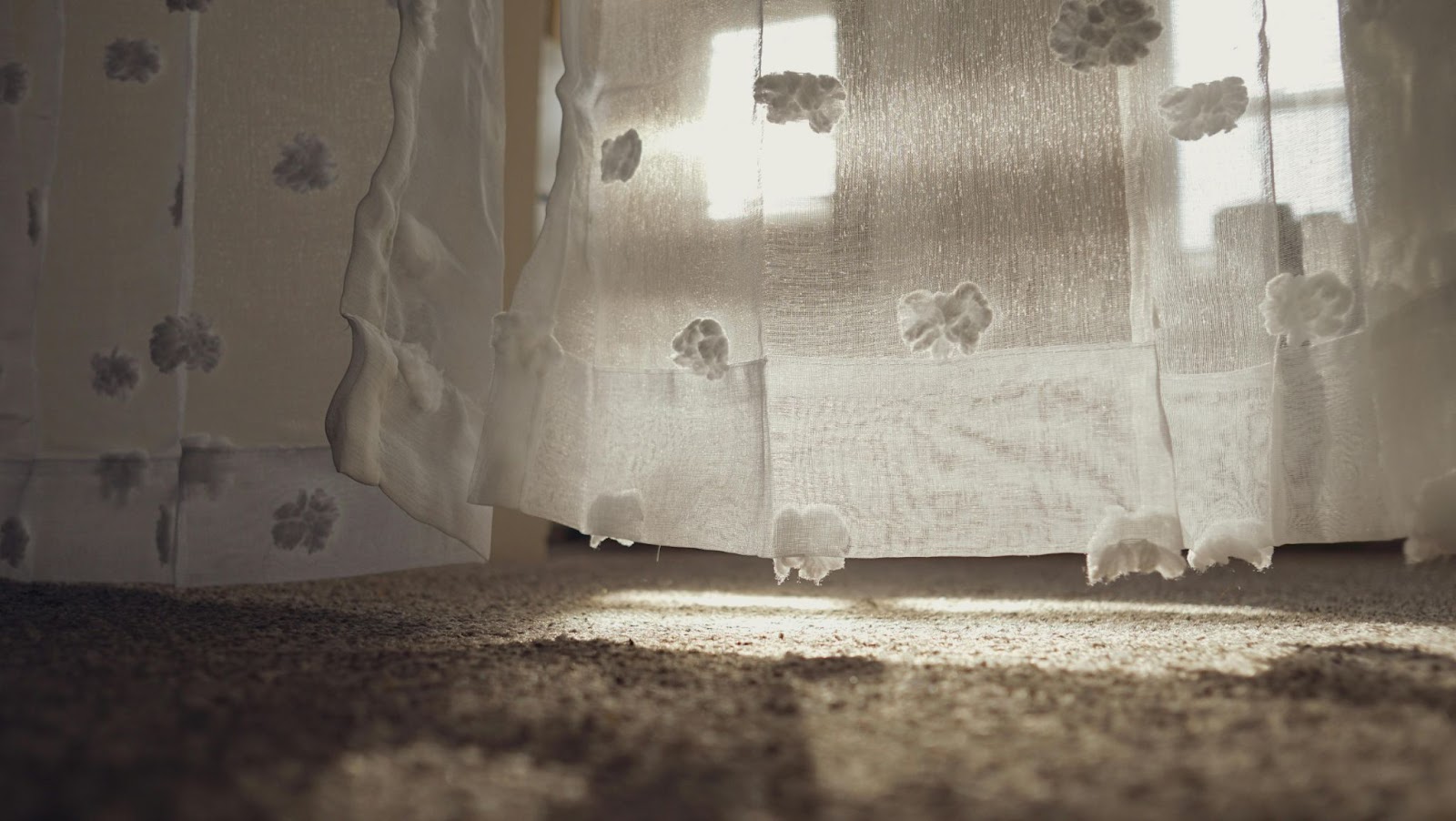Draperies take the brunt of daily life—sun exposure, humidity, even the occasional pet accident. Over time, those beautiful fabrics can show signs of wear you never expected: deep water stains, patches of mold, or lingering odors from urine. It’s easy to assume they’re ruined. But before you start shopping for replacements, there’s another option.
Professional restoration can often bring damaged draperies back to life, saving both money and materials. At BAYVIEW ON-SITE, we see it all—and more importantly, we know how to handle it.
Common Causes of Damage to Drapery Fabrics
Draperies might feel like the quiet backdrop of a room, but they take more abuse than most people realize. Day after day, they’re exposed to moisture, dust, and sunlight. And when life happens—like a burst pipe, a window left open in a storm, or a new puppy in the house—those everyday exposures can turn into lasting damage.
At BAYVIEW ON-SITE, we regularly restore draperies affected by:
- Water Damage: Rain, plumbing leaks, or roof issues can leave water spots that dry unevenly, causing discoloration or dark tide lines.
- Mold and Mildew: If draperies stay damp for too long, mold spores can start forming. These aren’t just unsightly—they pose real health concerns, especially for people with allergies.
- Urine Stains: Pets and little ones don’t always follow the rules. Urine doesn’t just stain—it soaks in deep, bringing strong odors and the risk of bacteria.
The stains themselves are only part of the issue. The real risk often comes afterward, when people try to fix the damage using the wrong methods. Draperies aren’t built to withstand harsh cleaning processes, and yet people often take them to laundromats or dry cleaners that treat them like ordinary fabrics. That can lead to shrinking, color fading, or dye bleeding—especially with delicate or custom materials.
Unfortunately, there’s no one-size-fits-all cleaning solution for draperies. Each fabric type responds differently to moisture, heat, and cleaning agents. Without the right tools and knowledge, well-intentioned attempts at cleaning can cause irreversible harm. Professional restoration ensures the fabric is treated with the appropriate methods from the start, avoiding further damage and restoring as much of the original look and feel as possible.
How BAYVIEW ON-SITE Restores Damaged Draperies
Restoring draperies—especially those affected by water, mold, or urine—takes more than just cleaning. It’s a careful, multi-step process that begins with understanding the fabric, the damage, and the safest path forward. At BAYVIEW ON-SITE, every professional restoration starts with a thorough inspection.
- Inspection
We begin by identifying the type of fabric and the extent of the damage. Whether it’s a water line creeping up from the hem or a patch of mold in a shaded corner, we assess everything in detail. This step helps us determine whether restoration is possible and how to approach it.
- Measurements
Next, we take precise measurements. Draperies can change shape when exposed to moisture, so it’s important to document their original dimensions. This ensures proper rehanging and appearance after cleaning.
- Proposal
Once we’ve evaluated the piece and confirmed a plan, we move forward with proposal acceptance. We walk clients through what to expect—whether stains can be fully removed, how the fabric may respond to treatment, and what results are realistic.
- HEPA-filter Vacuuming
Only after approval do we begin cleaning, starting with a HEPA filter vacuuming on both sides of the fabric. This step removes surface dust, dander, and mold spores before any moisture or treatment is introduced. It’s an important part of preventing stains from setting deeper.
- Dry Cleaning for Natural Fibers
Many draperies are made with natural fabrics like cotton, linen, or silk, which are particularly vulnerable to shrinking if exposed to moisture too early. That’s why we begin the stain treatment process with a specialized dry cleaning step—using an advanced injection/extraction machine that gently lifts soils without saturating the fabric. This ensures the draperies retain their original shape and structure before any wet cleaning is considered.
- Stain-Specific Treatment
Because dry cleaning alone can’t remove deeper issues—like water tide lines, urine stains, or mold spotting—we follow with a careful wet cleaning method. This involves targeted applications of California-compliant solutions, chosen specifically for the type of stain and the type of fabric. We take great care to avoid oversaturation, and we often repeat this process as needed to ensure the best possible outcome.
Throughout this step, our technicians focus not just on stain removal, but on preserving the integrity of the fabric. The goal is always to restore—not to over-clean. That means maintaining the original color, texture, and drape of the fabric wherever possible. It’s a meticulous balance of science, method, and artistry, and it’s where our team truly excels.
From there, we proceed with stain-specific pretreatment, using California-compliant solutions tailored to the problem—whether it’s protein from urine, mineral deposits from water, or organic buildup from mold. For more severe staining, we use a careful inject-and-extract method to target the damaged areas without oversaturating the fabric. When needed, we follow up with hand-applied water-soluble treatments to lift what remains.
This isn’t a one-size-fits-all service. Every drapery we restore gets an individualized professional restoration plan—and we only proceed if we believe the results will be worth it. We take pride in salvaging what many people assume is beyond saving.

Why Restoration Often Makes More Sense Than Replacement
When draperies show signs of serious damage—whether it’s visible water stains or the musty smell of mold—the first instinct for many homeowners is to replace them. But what gets overlooked is just how costly and time-consuming that can be.
Custom draperies aren’t cheap. Depending on the size, fabric, and design, replacing them can easily run into thousands of dollars. And that doesn’t include the wait time for new materials, consultations with a designer, or the hassle of reinstalling hardware. If the draperies are part of a matched set or made from discontinued fabrics, replacement might not even be possible.
Professional restoration offers a smarter alternative. At BAYVIEW ON-SITE, we often help clients restore high-end or sentimental draperies that would be difficult—or impossible—to replace. Whether it’s a tailored silk panel, a lined blackout drape, or a specialty Hunter Douglas fabric, restoration allows you to preserve your original investment without compromising on appearance.
And it’s not just about cost. Restoration is often faster, more convenient, and far less disruptive than starting from scratch. Our team comes onsite, handles the entire process with care, and gets your space back to looking its best—often in less time than it would take to even order new materials.
In the end, restoration isn’t just about saving fabric—it’s about saving value. The money you’ve already spent, the look you’ve carefully curated, the materials you may not be able to find again. When done right, professional restoration protects all of that and more.
The Science and Art of Restoration
Effective restoration isn’t just about equipment or cleaning solutions. It’s also about knowing when to stop. Our technicians are trained to approach every project with a methodical, scientific mindset combined with an artistic eye for detail.
It takes experience to know how far a fabric can be treated without compromising its integrity. And it takes care to preserve the character of each piece—especially when dealing with natural fibers, hand-sewn hems, or custom dye lots. At BAYVIEW ON-SITE, our team treats every drapery with the respect and precision it deserves.
Restoration Isn’t Just Repair—It’s Preservation
Draperies do more than block light or add texture to a room. They’re part of the home’s design story—often custom-fit, carefully chosen, and built to last. When that investment is damaged, replacing it isn’t always the best or most practical option. That’s where professional restoration becomes valuable—not just for saving money, but for preserving materials that were made to endure.
Still not sure if your water-stained or mold-affected draperies can be restored? The truth is, many can—especially when treated early and handled correctly.
Reach out to BAYVIEW ON-SITE to schedule an inspection. We’ll assess the damage, explain the process, and help you make an informed decision. You might be surprised by what’s still possible.
